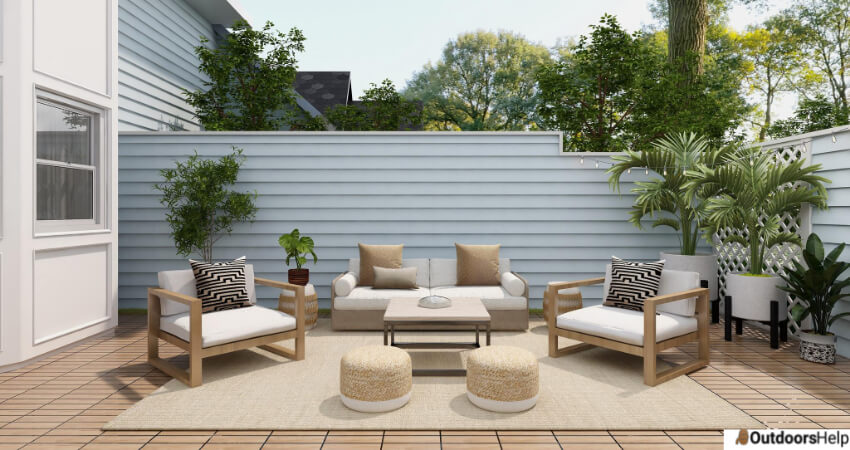Yes, outdoor rugs can get wet. It is inevitable for the outdoor rug to get wet as the wetness can be from rain or condensation. The problem that comes when your outdoor rug is wet is that it can cause mold mildew that causes unhealthy conditions for the rug. Imagine your rug rotting away in front of your house? To avoid all these fracases that come with wet outdoors, you can get outdoor rugs that may not get wet.
However, this article will take you through outdoor materials that resist water wetness, how you care for that outdoor rug and when the life of the outdoor rug is over.
What Is The Outdoor Material Rug That Isn’t Ruined While Wet?

Are there outdoor rugs that don’t get wet despite the availability of wet weather conditions? Yes, you can always get an easy way out if you don’t want your rug to get wet. Also, it will be a sigh of relief for you if you live in a place that has much rain and snow. Below are materials of outdoor rugs that will not get wet when they are in use.
1. Polypropylene
There are numerous benefits of using polypropylene. Polypropylene is a lightweight, rigid, durable material ideal for durable rugs or fitness carpets. It’s simple to clean in warm water with soap or detergents.
Polypropylene is also ideal for making attractive rugs that are safe and hygienic for the environment, thanks to its structural strength. Furthermore, it is so adaptable that it may be combined with various materials to make them fashionable and appealing. Also, the other merit is that polypropylene retains its strength when washed or dried repeatedly.
2. Polyester
When buying the outdoor rug, look for polyester material. Polyester is the best in the world and majorly durable and adaptable material. Polyester carpets come in various colors, amazing patterns, and varying levels of durability. Because it can resist prolonged contact with water, it will not be harmed if dampened in the rain. It is also very simple to clean and maintain.
3. Nylon
Suppose you’re thinking about getting a new water-resistant outdoor rug. Among the several options available on the market, Nylon is the best choice. You will obtain quality and durability at a reasonable price with this great rug style. Another advantage of Nylon is that it has no harmful impact on the environment.
How Do You Increase The Lifespan For Your Outdoor Rug?
1. Vacuum Clean Or Shake Out
Vacuum bigger rugs and shake out smaller rugs regularly. The vacuuming frequency depends on how often your family eats and drinks in that location. It also hinges on how much dust and grime flow around your home.
Cleaning your outdoor rug with a hose at least once a month to eliminate dust, filth, and grime is also a good idea.
2. Professional Clean
Has your natural fiber rug been professionally cleaned before the next spring and summer seasons? It is also true for higher-priced, long-lasting synthetic outdoor carpets.
Scrub synthetic rugs with weak bleach. Use a dish soap solution for solid-colored rugs—also, vinegar and water for vividly colored rugs to protect them.
3. Keep The Rug Dry
The easiest approach to keep your outdoor rug in good shape is to keep it dry. Make sure the rug dries completely on one side after heavy rain or mornings with heavy dew, then turn it and move it to another area so that both the rug’s bottom and the ground surface may dry.
To keep your outdoor rug from fading after the partying season is over, roll it up and store it in a dry, out-of-the-sun location.
When Does The Outdoor Rug Have An End To Its Lifespan?
You can acquire outdoor carpets at a very low cost. And, because they will be subjected to foot traffic, food spills, rain, sun, bugs, and biological agents such as mold and mildew, knowing when to replace them or get them cleaned and sanitized each season is paramount.
1. Continual Filthiness
If your outdoor rug has grown so filthy or faded that it no longer adds to the beauty of your outdoor space, kindly consider replacing it. While synthetic outdoor rugs are unlikely to develop mold, the ground beneath them can be left wet for long periods especially if you reside in a high-humidity environment.
2. Mold
If you find circular patterns of brown, green, or black stains on the carpet, you can tell if the rug harbors mold, mildew, or algae. You should know it needs to be removed or professionally cleaned the mold is evident.
3. Awful Odor
Mold and mildew growth can also be indicated by a strong, musty, or sour odor in the rug. These allergens can harm children, dogs, and people with allergies, so dispose of the rug or have it professionally cleaned before reusing it.
Frequently Asked Questions
Can You Keep Outdoor Rugs Out In The Rain?
Sun, humidity, mist, dust, and water droplets don’t bother the materials used to produce outdoor carpets. Outdoor rugs are available in various styles and materials, but only a handful can endure the rain. Such materials include Nylon, polypropylene, and polyester.
However, it is best to dry the rug after it has been wet for a long time, as persistent dampness might cause mold to grow.
Do Molds Grow On Outdoor Rugs?
Many people believe that utilizing synthetic in outdoor rugs will ensure long-term durability, support, and flexibility. However, if regularly exposed to water or humidity, an outdoor rug might grow moldy.
Are Outdoor Rugs Necessary?
Outdoor rugs are a necessity in every homestead. If you are holding an outdoors party, an outdoor rug is the best companion that compliments aesthetics. However, outdoor rugs get wet, and the wetness can result in decay, molds, smell, etc.
So what is the solution? You can get an outdoor rug that is resistant to water. Some materials are water-resistance, including Nylon, polyester, and polypropylene material. When choosing a rug, choose the one made of the materials mentioned in the article.

